Conspiracy theories thrive on cryptic symbols and covert visual signs. The ‘Eye of Providence’ – an eye set within a triangle – is one such symbol, associated with Freemasonry but also linked with the apocryphal Illuminati, a secret group of elite individuals allegedly seeking to control global affairs.
More like this:
- The strange power of the ‘evil eye’
- One of our earliest human symbols
- The ancient symbol that spanned millennia
The Eye of Providence is a lightning rod for conspiracy theorists because it is very much hidden in plain sight: not only does it appear on countless churches and Masonic buildings worldwide, it also features on the reverse of the American one-dollar bill as well as the Great Seal of the United States.
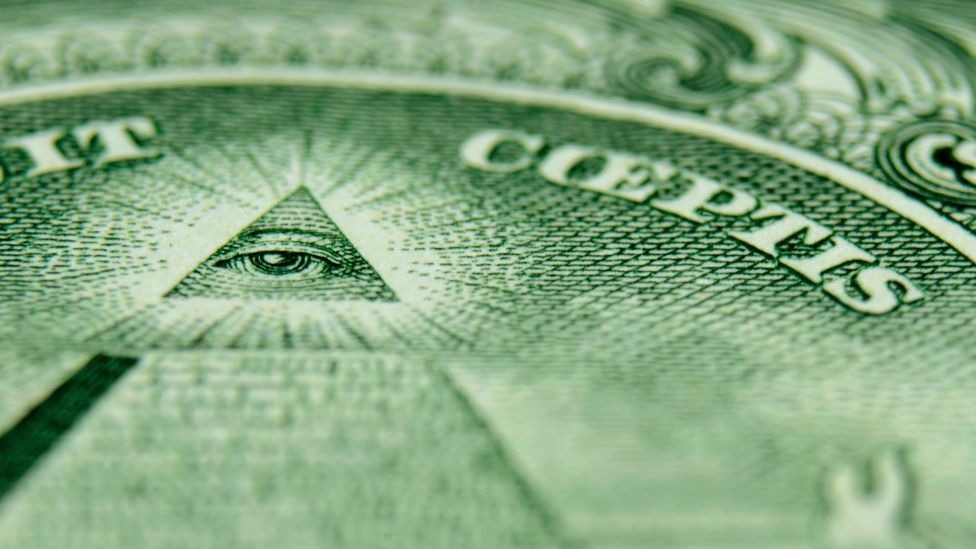
On the US $1 bill, the Eye of Providence is above a pyramid of 13 steps, symbolising the original states (Credit: Alamy)
In truth, it’s an uncanny and frankly odd choice for a US symbol of state. The disembodied eye strongly conveys the sense of a prying authoritarian Big Brother. In combination with the pyramid beneath it, we have emblems suggesting an ancient and esoteric cult. So, what are the origins of the Eye of Providence, why does it fascinate us so much, and why is it frequently connected with the Freemasons and the Illuminati?
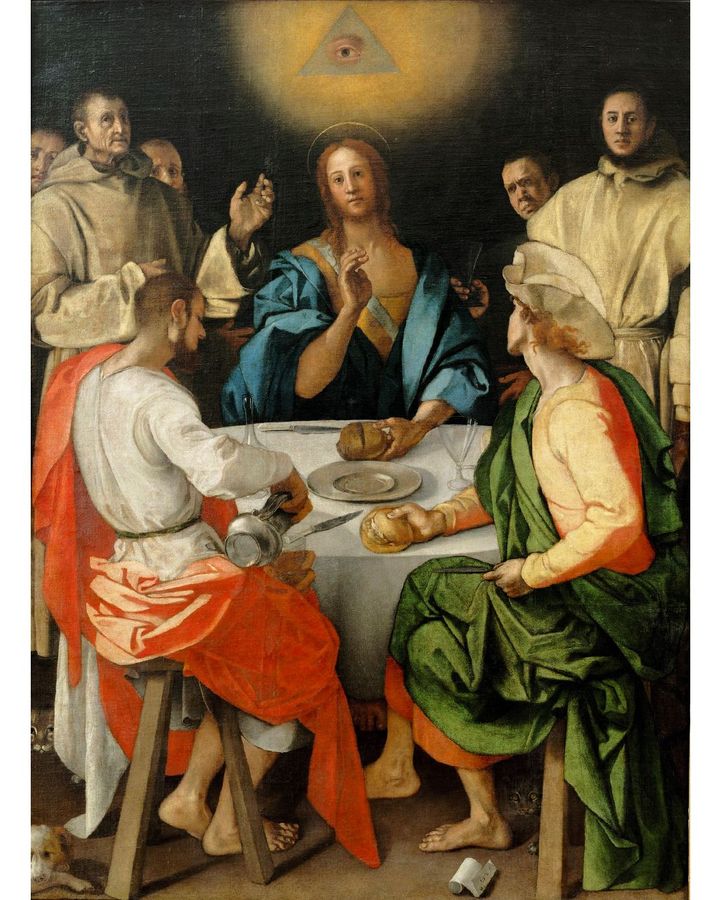
The divine eye in Pontormo’s Supper at Emmaus (1525) was a later repainting, hiding a three-sided face prohibited by the Counter-Reformation (Credit: The Uffizi Galleries)
Originally the Eye of Providence was a Christian symbol, and the earliest examples of its use can be found in religious art of the Renaissance period to represent God. An early example is Pontormo’s 1525 Supper at Emmaus, although the symbol itself was painted on later, perhaps in the 1600s.
Another key source of the icon was in a book of emblems called the Iconologia, published first in 1593. In later editions, the Eye of Providence was included as an attribute of the personification of ‘Divine Providence’, ie God’s benevolence. As the name of the symbol and its early usage suggest, it was invented as a sign of God’s compassionate watchfulness over humanity.
Building on the past
Nobody is certain who originally invented it, but whoever did crafted it out of a set of previously existing religious motifs. The triangle was a long-standing symbol of the Christian Trinity of Father, Son and Holy Spirit; sometimes in previous centuries God was even depicted with a triangular halo. The rays of light that are often shown emanating from the symbol are also a pre-existing sign of God’s radiance in Christian iconography. But what are the origins of that eerie disembodied eye? God had been depicted in numerous cryptic ways before, such as by a single hand emerging from a cloud, but not as an eye.
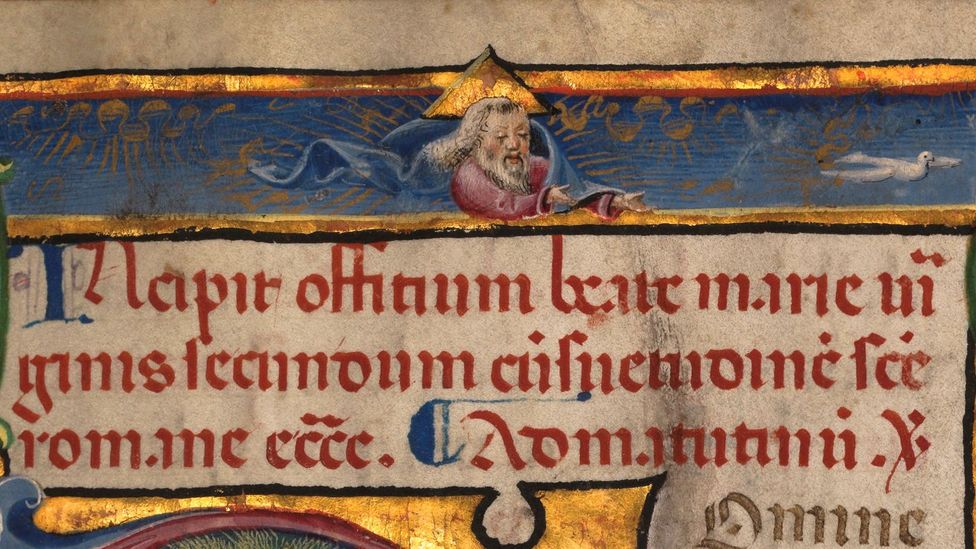
In the Book of Hours, God is depicted with a triangular halo, referring to the Christian Trinity of Father, Son and Holy Spirit (Credit: University of Basel)
It’s fair to say that an eye represented in isolation has its own inherent psychological impact, showing authority and for the viewer implying a sentient watchfulness. You can even see this effect in nature, with some animals having evolved ‘eyespots’ on their skin to scare off predators. The Surrealist photographer Man Ray summarised the uncanniness of the disembodied eye best when he said that René Magritte’s The False Mirror of 1929 “sees as much as it itself is seen.”
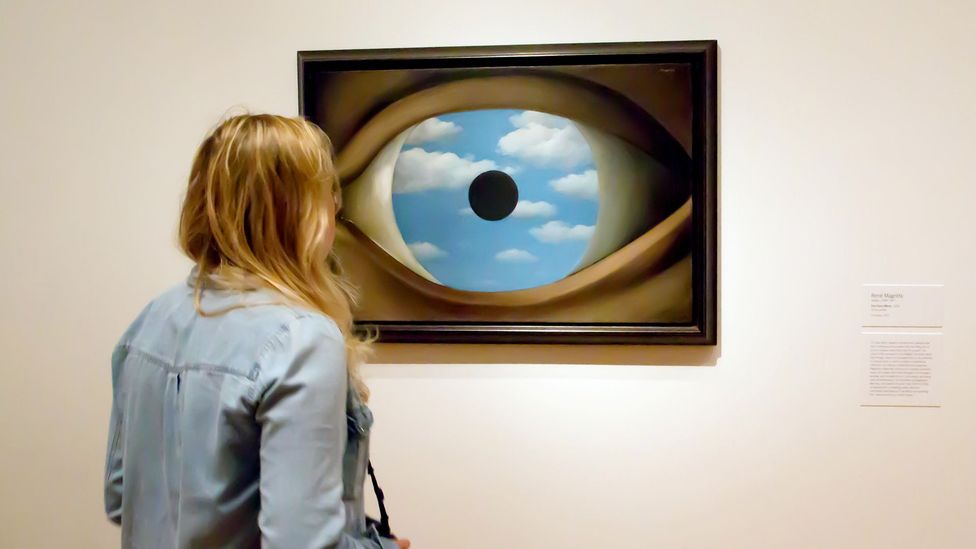
The eye fascinated Surrealists, with its threshold position between the inner self and the external world – shown here in Magritte’s The False Mirror (1929) (Credit: Alamy)
But there is a deeper history to the eye as a symbol to consider – one that takes us back to the earliest known religions. In the third millennium BCE, the Sumerians conveyed the holiness of certain sculptures by abnormally enlarging their eyes to enhance the sensation of dutiful watchfulness. They even held ceremonies in which artists brought the sculptures to life by ‘opening’ the figures’ eyes.
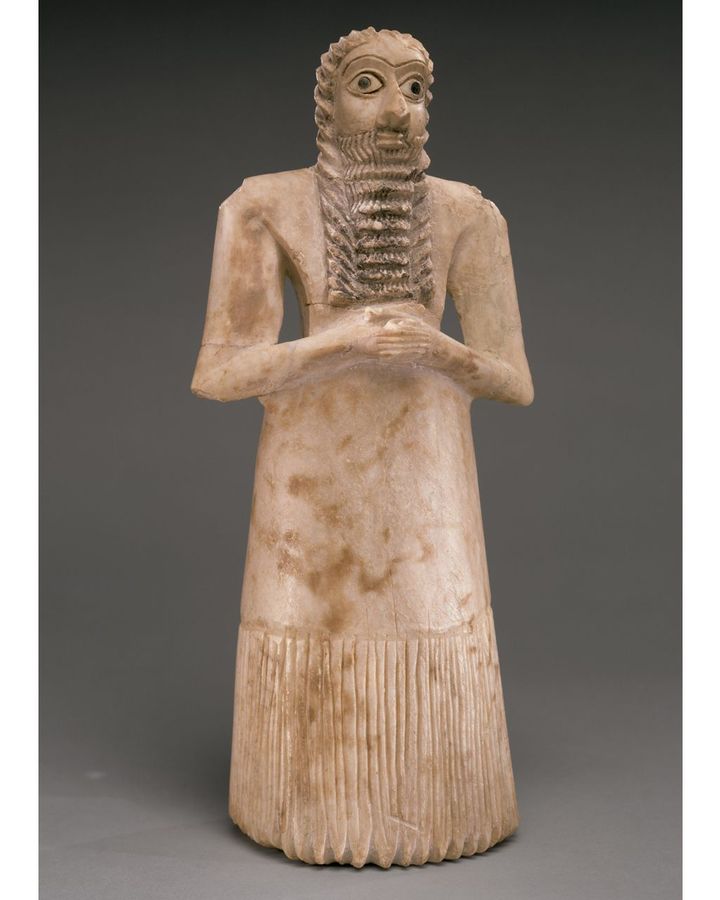
The Sumerians used abnormally large eyes to convey the holiness of divine figures (Credit: Metropolitan Museum of Art)
But it was the ancient Egyptians who were the originators of the detached eye as a motif: for example, a pair of eyes painted on a coffin that allowed the dead to see in the afterlife. And one of the most famous of all Egyptian symbols is the Eye of Horus.
This motif is actually a hybrid of a human and falcon eye, and it includes the bird’s dark eyebrow and cheek markings. According to ancient Egyptian mythology, the god-King Horus (often depicted as a falcon, or with a falcon’s head) had his eyes cut out in battle with his uncle Set. With the help of Thoth, he later healed his eyes. The Eye of Horus was therefore a protective symbol, often used as an amulet, a sculpture small enough for a person to carry in their pocket as a form of protection.
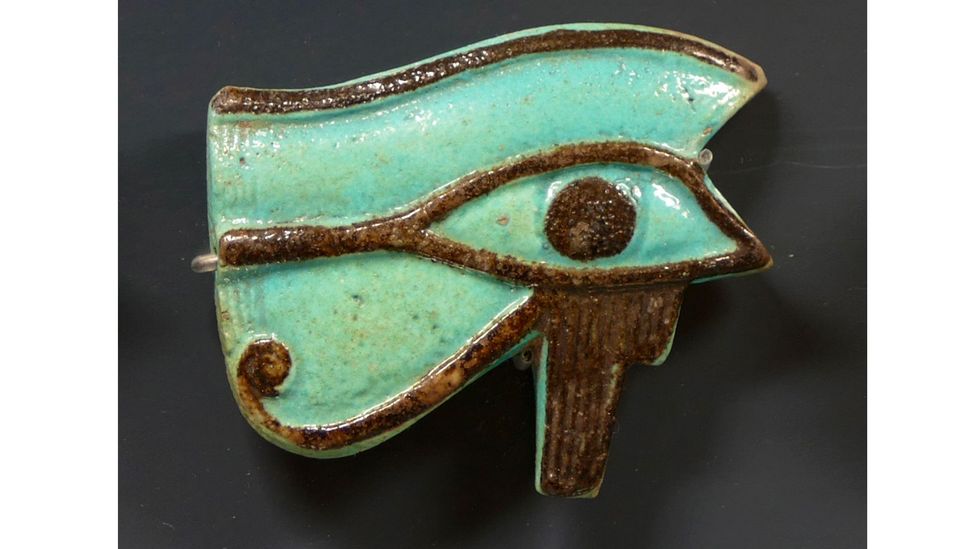
The Eye of Horus – a hybrid of a human and falcon eye – was carried as a form of protection (Credit: Alamy)
This and other Egyptian hieroglyphs of isolated human eyes went on to affect European iconography during the Renaissance. At that time, scholars and artists had a fascination with Egyptian writing; the only problem was that they didn’t fully understand it, and attempted translations were normally riddled with inaccuracies. One of the most famous appeared in a romance of 1499 titled The Dream of Poliphilo where the translation of an Egyptian single eye symbol was ‘God’.
Lost in translation
This stemmed from a fundamental misunderstanding of hieroglyphics’ original use. Nowadays we know that they are a written language of mainly phonetic signs, but in the 1400s and 1500s they were believed to have a much more mystical significance. The symbols in hieroglyphic writing – animals, birds and abstract shapes – were thought to be deliberately mysterious, each one creating meaning through the inspiration of the viewer rather than being part of a linguistic system. They were, so it was believed, open puzzles that contained multiple meanings.
This belief had a huge effect on European art. When dictionaries of symbols, such as Andrea Alciati’s 1531 Emblemata and later Cesare Ripa’s Iconologia came out, the emphasis was on cryptic, often highly complex visual symbols where the viewer is enrolled as a participant in deciphering as well as constructing meanings from them.
As a result, a motif like the Eye of Providence was deliberately esoteric in its appearance. It’s a symbol almost purpose-built to be reinterpreted, and maybe even misinterpreted. And this really came to fruition in the late 18th Century. Three key examples from this period demonstrate an increasing diversity in the symbolism of the Eye of Providence.

The Eye of Providence appeared at the top of Jean-Jacques-François Le Barbier’s 1789 depiction of The Declaration of the Rights of Man and of the Citizen (Credit: Alamy)
In post-revolutionary France, Jean-Jacques-François Le Barbier’s 1789 The Declaration of the Rights of Man and of the Citizen featured the text of the radical new declaration with the Eye of Providence at the top. In this case, it has become an instrument of paternalistic reason watching over the newly egalitarian nation.
In Britain in 1794 Jeremy Bentham commissioned the architect Willey Reveley to design him a logo for his ‘Panopticon’– a revolutionary new prison aiming to allow for continual surveillance of each cell. The resulting design prominently included the Eye of Providence – a symbol now of the unblinking stare of judiciary righteousness – surrounded by the words ‘Mercy’, ‘Justice’ and ‘Vigilance’.
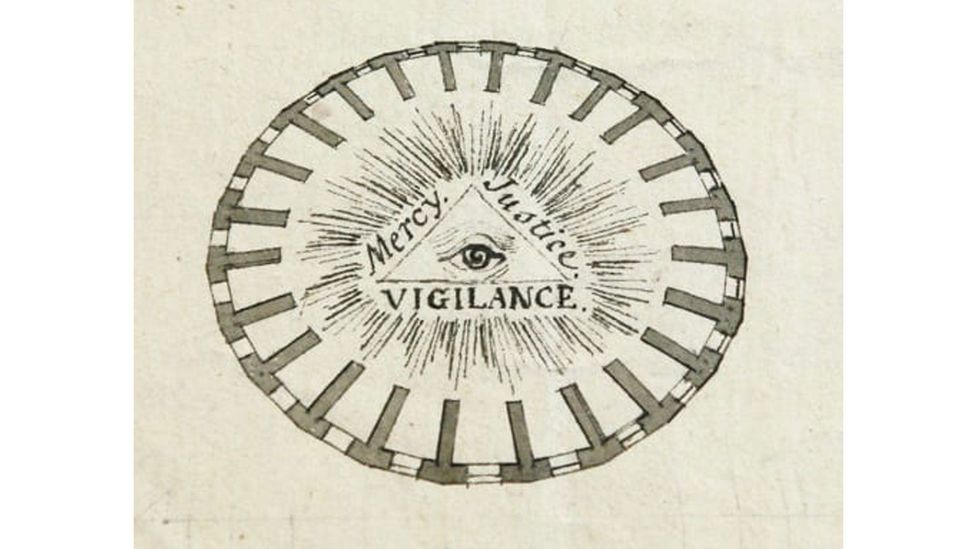
A rotunda surrounding an inspection tower, Bentham’s Panopticon prison was designed to ensure that inmates never knew when they were being watched (Credit: Public Domain)
A few years earlier, in 1782 the Great Seal of the United States of America was unveiled. Thomas Jefferson, Benjamin Franklin and John Adams had proposed ideas for the design, but it was Charles Thomson, Secretary of the Continental Congress, who came up with the pyramid and Eye of Providence, among the other elements of the seal, in collaboration with a young lawyer and artist named William Barton. The unfinished pyramid was intended to symbolise “strength and duration”, with 13 levels to represent the 13 original states of America. The Eye of Providence – like the other two examples from the same period in Britain and France – was a conventional symbol for God’s sympathetic oversight of this fledgling nation. In none of those examples was Freemasonry involved with the choice of symbol.
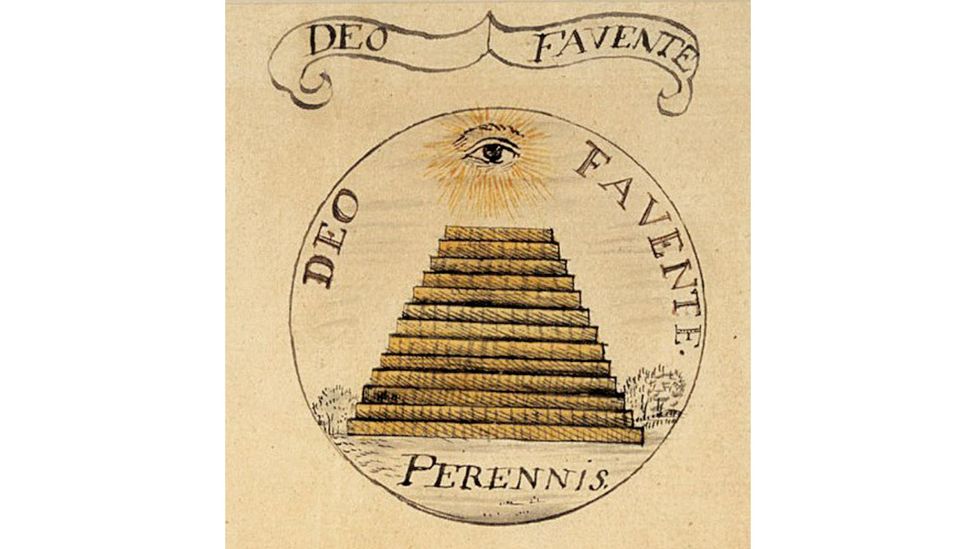
William Barton’s design for the Great Seal of the United States was used on the reverse side, although with changed mottos (Credit: Alamy)
So how about the Illuminati? The details of the early years of the original group, founded in Bavaria in 1776 and disbanded in 1787, are relatively obscure. Inconveniently we also don’t know how important visual symbols were to the original order. It is true that the Illuminati were inspired by the ideas behind Freemasonry, which had sporadically used the Eye of Providence as a symbol of the Supreme Architect (God), following the lead of many other churches at the time.
However, the Masons didn’t use the Eye of Providence symbol widely until at least the late 18th Century, and not before Bentham, Le Barbier, Thomson and Barton had adopted it for their very mainstream purposes. Unfortunately for the conspiracy theorists, the Eye of Providence on the one-dollar bill tells us much more about late 18th-Century aesthetics than it does about the authority of secret elites.
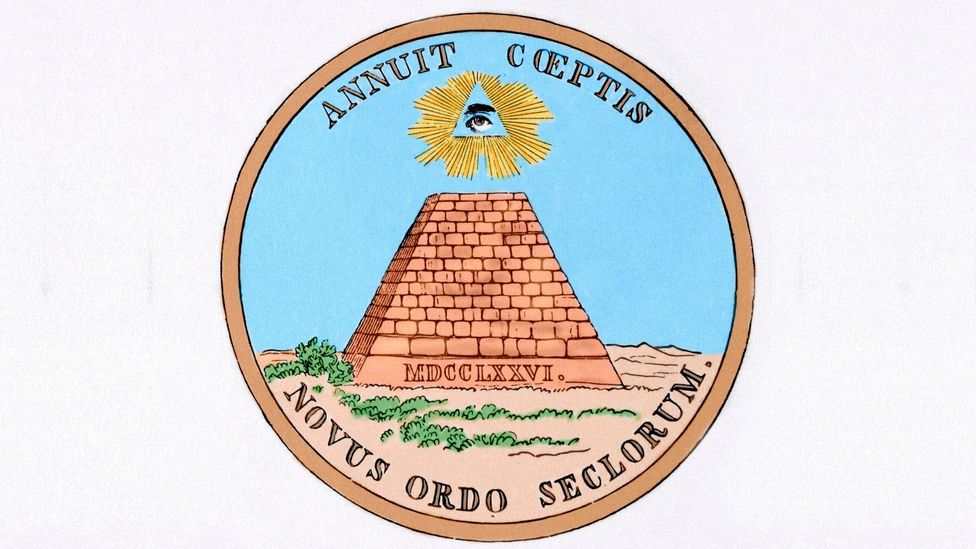
The principal national symbol of the US, the Great Seal was first used in 1782 (Credit: Alamy)
And into our modern age, Madonna, Jay-Z and Kanye West have all been accused of using Illuminati iconography, including the Eye of Providence. But rather than any link to the Illuminati, what each music artist has in common is a discerning eye for the iconic (and perhaps for provocation) – in visuals as much as in melody. The repeated use of the Eye of Providence – and we can apply this as much to Madonna and Jay-Z as to Bentham, Le Barbier, Thomson, Barton, the Freemasons, Renaissance artists or pretty much any other individual or group – is proof not of a concerted conspiracy, but of its enduring brilliance as a piece of logo design.
If you would like to comment on this story or anything else you have seen on BBC Culture, head over to our Facebook page or message us on Twitter.
And if you liked this story, sign up for the weekly bbc.com features newsletter, called The Essential List. A handpicked selection of stories from BBC Future, Culture, Worklife and Travel, delivered to your inbox every Friday.
"with" - Google News
November 13, 2020 at 07:33AM
https://ift.tt/36vSjK7
The Eye of Providence: The symbol with a secret meaning? - BBC News
"with" - Google News
https://ift.tt/3d5QSDO
https://ift.tt/2ycZSIP
Bagikan Berita Ini














0 Response to "The Eye of Providence: The symbol with a secret meaning? - BBC News"
Post a Comment